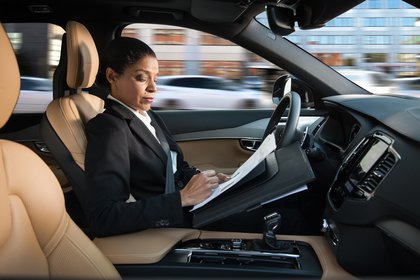
29/01/2019
Autonomous vehicles, drive-assist levels explained
Simonluca Pini - Contributor Editor de Il Sole 24 Ore
Adas systems, a regular feature now on all newly registered cars, and the development of artificial intelligence are shaping future mobility scenarios in which the human factor will lose its central role.
Autonomous driving will soon be a reality. In a market where Adas systems are now a regular feature on all newly registered cars, new mobility scenarios are opening up, meaning that the human factor is bound to lose the central role it has played to date. However, a futuristic Blade Runner-style scenario, where the vehicle will be responsible for driving and controlling the surrounding environment, is still a long way from our everyday life. It is therefore important to be aware of the different levels of automation and distinguish between the different drive-assist devices on board. In 2014, the Sae (Society of automotive engineers) created guidelines to distinguish and identify the level of automation in a vehicle. However, to date there is still no substitute for caution as no system is able to exclude the driver from controlling the vehicle and level 5 autonomous driving systems (the ultimate autonomous-driving dream) are still being studied and tested.
Autonomous driving levels
1) Level 0
The driver controls every feature of the vehicle, even if equipped with an alert system. There is no automation. The driver is entirely responsible for steering, accelerating, driving comfort and managing cases of emergency. This level includes also vehicles equipped with systems such as lane departure warning and blind spot detection.
2) Level 1
This level comes with some drive-assist devices. In some cases the system controls steering and speed while the driver will control all the remaining systems. Steering and speed control are managed by both the driver and the system, while the supervision of the surrounding environment is exclusively in the hands of the driver. On the road, it translates into a lane maintenance system able to take over and steer the vehicle back in the lane, and adaptive cruise control, able to maintain a standard distance from other cars and to slow down if necessary.
3) Level 2
Moving on, level 2 means partial automation on board. The system can control all the dynamic aspects of driving while the driver supervises the rest. Steering and speed can be entrusted to the system, while the driver must monitor the driving and be prepared to intervene immediately at any time if the automated system fails to respond properly. With level 2, cars cannot circulate in a semi-autonomous mode in contexts such as motorway sections. The systems on board allow the driver to take the “hands off” the wheel for a few moments, however, in addition to being prohibited by the Highway Code, it is essential to be in full control at all times and not be distracted.
4) Level 3
Level 3 brings a higher level of automation with it and the system controls all the dynamic aspects of driving, with the driver responsible for responding promptly when called upon. The system controls steering, speed and the surrounding environment but the driver must be ready to act if dangerous situations should arise. In level 3 vehicles the system is able to drive the vehicle independently, without the need for human intervention, on stretches of road such as motorways and expressways. This is possible after the driver, who can take his hands off the wheel, activates the system but stays alert and ready to take over. Current legislations, though, do not allow the use of this system on normal roads.
5) Level 4
Level 4 means high automation. The system can control all the dynamic aspects of the car even if the driver fails to intervene in case of need. This translates into the system's ability to control steering, speed and the surrounding environment. It is also capable of handling dynamic situations without the support of the driver. To date, no production car on the market is level-4-ready, only a few prototypes are being tested.
6) Level 5
The last level on the Sae classification means complete automation. The system replaces the driver in all aspects, starting from dynamic situations in all conditions and roads. The system therefore has total control of the vehicle and the driver no longer needs to drive.
Autonomous driving levels
1) Level 0
The driver controls every feature of the vehicle, even if equipped with an alert system. There is no automation. The driver is entirely responsible for steering, accelerating, driving comfort and managing cases of emergency. This level includes also vehicles equipped with systems such as lane departure warning and blind spot detection.
2) Level 1
This level comes with some drive-assist devices. In some cases the system controls steering and speed while the driver will control all the remaining systems. Steering and speed control are managed by both the driver and the system, while the supervision of the surrounding environment is exclusively in the hands of the driver. On the road, it translates into a lane maintenance system able to take over and steer the vehicle back in the lane, and adaptive cruise control, able to maintain a standard distance from other cars and to slow down if necessary.
3) Level 2
Moving on, level 2 means partial automation on board. The system can control all the dynamic aspects of driving while the driver supervises the rest. Steering and speed can be entrusted to the system, while the driver must monitor the driving and be prepared to intervene immediately at any time if the automated system fails to respond properly. With level 2, cars cannot circulate in a semi-autonomous mode in contexts such as motorway sections. The systems on board allow the driver to take the “hands off” the wheel for a few moments, however, in addition to being prohibited by the Highway Code, it is essential to be in full control at all times and not be distracted.
4) Level 3
Level 3 brings a higher level of automation with it and the system controls all the dynamic aspects of driving, with the driver responsible for responding promptly when called upon. The system controls steering, speed and the surrounding environment but the driver must be ready to act if dangerous situations should arise. In level 3 vehicles the system is able to drive the vehicle independently, without the need for human intervention, on stretches of road such as motorways and expressways. This is possible after the driver, who can take his hands off the wheel, activates the system but stays alert and ready to take over. Current legislations, though, do not allow the use of this system on normal roads.
5) Level 4
Level 4 means high automation. The system can control all the dynamic aspects of the car even if the driver fails to intervene in case of need. This translates into the system's ability to control steering, speed and the surrounding environment. It is also capable of handling dynamic situations without the support of the driver. To date, no production car on the market is level-4-ready, only a few prototypes are being tested.
6) Level 5
The last level on the Sae classification means complete automation. The system replaces the driver in all aspects, starting from dynamic situations in all conditions and roads. The system therefore has total control of the vehicle and the driver no longer needs to drive.








